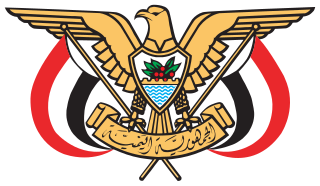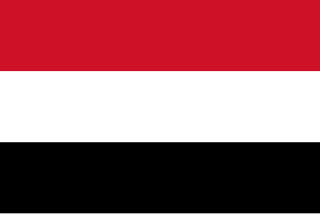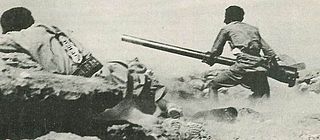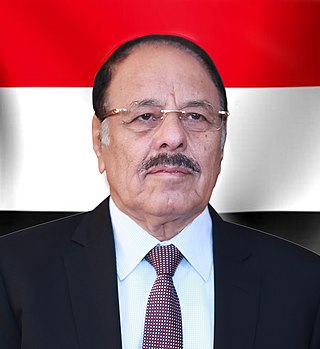
The Politics of Yemen are in an uncertain state due to the Houthi takeover in Yemen. An armed group known as the Houthis or Ansar Allah seized control of the Northern Yemeni government and announced it would dissolve parliament, as well as install a "presidential council", "transitional national council", and "supreme revolutionary council" to govern the country for an interim period. However, the deposed president, Abdrabbuh Mansur Hadi, has declared he is still in office and is working to establish a rival government in Aden.

The president of the Republic of Iraq is the head of state of Iraq and "safeguards the commitment to the Constitution and the preservation of Iraq's independence, sovereignty, unity, the security of its territories in accordance with the provisions of the Constitution". The president is elected by the Council of Representatives by a two-thirds majority, and is limited to two four-year terms. The president is responsible for ratifying treaties and laws passed by the Council of Representatives, issues pardons on the recommendation of the prime minister, and performs the "duty of the Higher Command of the armed forces for ceremonial and honorary purposes". Since the mid-2000s, the presidency is primarily a symbolic office, as the position does not possess significant power within the country according to the October 2005-adopted constitution. By convention, though not by any official legal requirement, the office is expected to be held by a Kurd.

The flag of Yemen was adopted on May 22, 1990, the day that North Yemen and South Yemen were unified. The flag of Yemen resembles the Arab Liberation Flag of July 23, 1952, introduced after the Egyptian Revolution of 1952 in which Arab nationalism was a dominant theme. The Arab Liberation Flag of July 23, 1952 served as the derivation for the flags of both North and South Yemen prior to unification by omiting the distinctive elements from the existing designs, as well as for the current flags of Egypt, Iraq, Sudan, Palestine and Syria.

The president of the Republic of Yemen is the head of state of Yemen. Under the Constitution of Yemen, the president is also the Supreme Commander of the Armed Forces and head of the executive branch of the Yemeni government.

The Yemen Arab Republic, commonly known as North Yemen or Yemen (Sanaʽa), was a country that existed from 1962 to 1990 in the northwestern part of what is now Yemen. Its capital was at Sanaa. It united with the People's Democratic Republic of Yemen on 22 May 1990 to form the current Republic of Yemen.

The Prime Minister of the Yemen Arab Republic, also known as the Chairman of the Council of Ministers of the Yemen Arab Republic, was the head of government of that country in what is now northern Yemen. The Prime Minister was appointed by the President. There were twelve prime ministers of North Yemen.

Abdul Karim Abdullah al-Arashi, was a Yemeni politician who served as the President of the Yemen Arab Republic briefly from 24 June to 18 July 1978. He was preceded by Ahmed Al-Ghashmi and succeeded by Ali Abdullah Saleh. He also served as Vice President of Yemen Arab Republic, from 1978 to 1990, and the Speaker of the Constituent People's Assembly (Parliament) from 1978 to 1988, and the president of the Shura Council from 1988 to 1990.

Elections in Yemen take place within the framework of a presidential system, with both the President and House of Representatives elected by the public. Due to political instability, elections have not been held regularly since the early 2000s.

Muhammad Hussein Tantawi Soliman was an Egyptian field marshal and politician. He was the commander-in-chief of the Egyptian Armed Forces and, as chairman of the Supreme Council of the Armed Forces, was the de facto head of state from the ousting of President Hosni Mubarak on 11 February 2011 until the inauguration of Mohamed Morsi as president of Egypt on 30 June 2012.

The North Yemen civil war was a civil war fought in North Yemen from 1962 to 1970 between partisans of the Mutawakkilite Kingdom and supporters of the Yemen Arab Republic. The war began with a coup d'état carried out in 1962 by revolutionary republicans led by the army under the command of Abdullah as-Sallal. He dethroned the newly crowned King and Imam Muhammad al-Badr and declared Yemen a republic under his presidency. His government abolished slavery in Yemen. The Imam escaped to the Saudi Arabian border where he rallied popular support from northern Zaydi tribes to retake power, and the conflict escalated rapidly to a full-scale civil war.

Yemeni unification took place on 22 May 1990, when the People's Democratic Republic of Yemen was united with the Yemen Arab Republic, forming the Republic of Yemen.

The modern history of Yemen began with the withdrawal of the Ottoman Empire. In 1839 the British set up a protective area around the southern port of Aden and in 1918 the northern Kingdom of Yemen gained independence from the Ottoman Empire. North Yemen became a republic in 1962, but it was not until 1967 that the British Empire withdrew from what became South Yemen. In 1970, the southern government adopted a communist governmental system. The two countries were officially united as the Republic of Yemen on May 22, 1990.

The Imams of Yemen and later also the Kings of Yemen were religiously consecrated leaders belonging to the Zaidiyyah branch of Shia Islam. They established a blend of religious and political rule in parts of Yemen from 897. Their imamate endured under varying circumstances until the republican revolution in 1962, then the formal abolition of the monarchy in 1970. Zaidiyyah theology differed from Ismailis or Twelver Shi'ites by stressing the presence of an active and visible imam as leader. The imam was expected to be knowledgeable in religious sciences, and to prove himself a worthy headman of the community, even in battle if this was necessary. A claimant of the imamate would proclaim a "call" (da'wa), and there were not infrequently more than one claimant. The historian Ibn Khaldun mentions the clan that usually provided the imams as the Banu Rassi or Rassids. In the original Arab sources the term Rassids is otherwise hardly used; in Western literature it usually refers to the Imams of the medieval period, up to the 16th century. The Rassid branch that came to power with imam al-Mansur al-Qasim is known as Qasimids.

The Imams of Yemen, later also titled the Kings of Yemen, were religiously consecrated leaders (imams) belonging to the Zaidi branch of Shia Islam. They established a blend of religious and temporal-political rule in parts of Yemen from 897. Their imamate endured under varying circumstances until the end of the North Yemen civil war in 1970, following the republican revolution in 1962. Zaidi theology differs from Isma'ilism and Twelver Shi'ism by stressing the presence of an active and visible imam as leader. The imam was expected to be knowledgeable in religious scholarship, and to prove himself a worthy headman of the community, even in battle if this was necessary. A claimant of the imamate would proclaim a "call" (dawah), and there were not infrequently more than one claimant.

The Cabinet of Yemen refers to the governing body of the internationally recognized government of the Republic of Yemen, led by its President Rashad al-Alimi, who is also the chairman of the Presidential Leadership Council (PLC), the governing body of Yemeni republic.

Ali Mohsen Saleh al-Ahmar, sometimes spelled Muhsin, is a Yemeni military officer who served as the vice president of Yemen from 2016 to 2022, when he was dismissed by President Abdrabbuh Mansur Hadi, who transferred the powers of the president and vice president to the Presidential Leadership Council. He is a general in the Yemeni Army and was the commander of the northwestern military district and the 1st Armoured Division. He played a leading role in the creation of the General People's Congress.

The Vice President of the Republic of Yemen is the second highest political position in Yemen.

A Unified Political Command, also translated as Joint Political Command or Unified Political Leadership, was agreed in 1964 between the presidents of Egypt and Iraq as well as between the presidents of Egypt and North Yemen. Both projects were parallel but not linked with each other. The Unified Political Command was meant as a kind of transitional government which should prepare the gradual merger of Iraq with Egypt and North Yemen with Egypt in a new United Arab Republic.





















